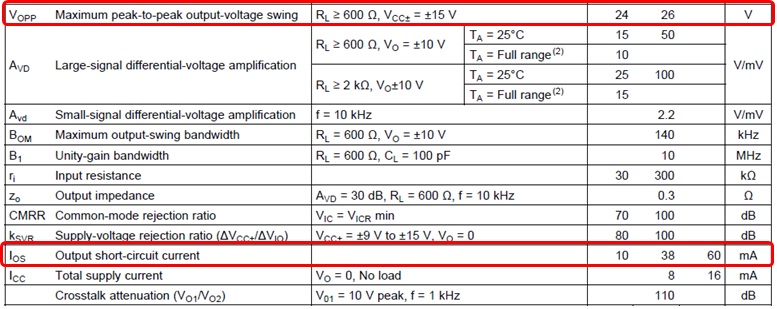After contacting TI, here are excerpts from the response I received.
"20mA is supported at room temperature (25C) as you said 12V/600 ohms.
25mA assumption is fair, It is reasonable to expect at least this much current from -40C to 85C
Nevertheless, the data sheet doesn't directly support this claim.
It is odd that Vopp supports 20mA with a 3V headroom yet a short has a minimum of 10mA. So I checked old data sheet revisions and saw that the 10/60 limits were added in May of 2000. But why was that? I checked for NE5532 competitors at Digikey and saw that other device also has 10/60 limit. So someone replicated the limit and someone else created the original unwarranted 10mA minimum. In any case, 10mA just doesn't make sense.
The Avd spec doesn't show any weakness, but it does indirectly support at least 16.7mA current drive across full temperature range as DC gain is >10k
Here is a 50 amplifier char result for NE5532."
IOS-
LotID.Tmp Mean StdDev Mean-3s LowRead HiRead Mean+3s Reads
-----------------+---------------------------------------------------------------------------------
-40C | -48.027mA 105.198uA -48.342mA -48.096mA -47.607mA -47.711mA 50
0C | -48.044mA 65.629uA -48.240mA -48.218mA -47.974mA -47.847mA 50
25C | -48.015mA 119.972uA -48.374mA -48.096mA -47.607mA -47.655mA 50
70C | -46.818mA 1.537mA -51.429mA -48.096mA -41.748mA -42.207mA 50
85C | -44.633mA 1.124mA -48.005mA -45.654mA -40.283mA -41.261mA 50
-----------------+---------------------------------------------------------------------------------
IOS2+
LotID.Tmp Mean StdDev Mean-3s LowRead HiRead Mean+3s Reads
-----------------+---------------------------------------------------------------------------------
-40C | 47.194mA 390.580uA 46.022mA 46.730mA 48.002mA 48.365mA 50
0C | 47.032mA 395.059uA 45.846mA 46.094mA 47.525mA 48.217mA 50
25C | 46.641mA 310.048uA 45.710mA 46.094mA 47.366mA 47.571mA 50
70C | 46.482mA 298.172uA 45.587mA 46.094mA 46.889mA 47.376mA 50
85C | 46.434mA 316.390uA 45.484mA 46.094mA 46.889mA 47.383mA 50

